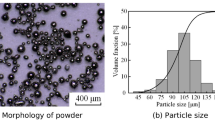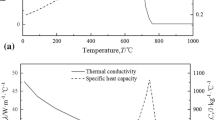Abstract
In order to achieve the restoration of the sprocket, it is significant to repair or modify the damaged sprocket by using an advanced surface treatment technique, such as the laser cladding process. In this paper, the Taguchi method was applied to conduct the experiment to optimize the process parameters for repairing a sprocket in the laser cladding process. The dilution was chosen to evaluate the quality of the cladding layer and the effect of the process parameters, such as the laser power, scanning speed, and powder feeding rate, with respect to the cladding layer geometry, and the dilution was investigated systematically. Then, using the optimized parameters, the sprocket was remanufactured and its surface profile characteristics, microstructure, and microhardness of the repaired sprocket were analyzed. The results show that the optimal process parameters (1000 W, 2.81 g/min, 1200 mm/min) obtained by the Taguchi method could realize the lower dilution. With the optimal parameters, the repair accuracy of the sprocket could reach 2.973 mm, which offers the machining allowance for machining of the sprocket. A white bright band observed at the interface shows that the metallurgical bonding was realized between the cladding zone and base metal. The microhardness of the cladding zone is higher than that of the heat-affected zone and base metal. Furthermore, the results reveal that the Taguchi method can effectively acquire the optimal combination of process parameters, and the laser cladding process exhibits good feasibility and effectiveness for repairing the machinery components with complex shapes.
Similar content being viewed by others
References
Serres N, Hlawka F, Costil S, Langlade C, Machi F, Cornet A (2009) Dry coatings and ecodesign: part. 2—tribological performances. Surf Coat Tech 204:197–204
Yang D, He C, Zhang G (2016) Forming characteristics of thin-wall steel parts by double electrode GMAW based additive manufacturing. J Mater Process Technol 227:153–160
Ji R, Liu Y, Xu C, Li X, Cai B, Zhang Y (2016) Novel method for the hybrid composite electroplating of the upstream pum** mechanical seal. Int J Adv Manuf Technol. doi:10.1007/s00170-016-9244-6
Unocic R, DuPont J (2004) Process efficiency measurements in the laser engineered net sha** process. Metallurg Mater Trans B 35:143–152
Lewis GK, Schlienger E (2000) Practical considerations and capabilities for laser assisted direct metal deposition. Mate Des 21(4):417–423
Vaithilingam J, Goodridge RD, Hague RJM, Christie SDR, Edmondson S (2016) The effect of laser remelting on the surface chemistry of Ti6al4V components fabricated by selective laser melting. J Mater Process Technol 232:1–8
Liu Y, Yang Y, Wang D (2016) A study on the residual stress during selective laser melting (SLM) of metallic powder. Int J Adv Manuf Technol 87:647–656
Toyserkani E, Khajepour A, Corbin S (2005) Laser cladding. CRC Press, Boca Raton, Florida
Qi H, Azer M, Singh P (2010) Adaptive toolpath deposition method for laser net shape manufacturing and repair of turbine compressor airfoils. Int J Adv Manuf Technol 48:121–131. doi:10.1007/s00170-009-2265-7
Pinkerton AJ, Wang W, Li L (2008) Component repair using laser direct metal deposition. P I Mech Eng B-J Eng 222:827–836
Liu D, Lippold JC, Li J, Rohklin SR, Vollbrecht J, Grylls R (2014) Laser engineered net shape (LENS) technology for the repair of Ni-base superalloy turbine components. Metall Mater Trans A 45A(10):4454–4469
Lin C (2015) Parameter optimization of laser cladding process and resulting microstructure for the repair of tenon on steam turbine blade. Vacuum 115:117–123
Paydas H, Mertens A, Carrus R, Lecomte-Beckers J, Tchoufang Tchuindjang J (2015) Laser cladding as repair technology for Ti–6Al–4V alloy: influence of building strategy on microstructure and hardness. Mate Des 85:497–510
Liu Q, Wang Y, Zheng H, Tang K, Li H, Gong S (2016) TC17 titanium alloy laser melting deposition repair process and properties. Opt Laser Technol 82:1–9
Lawrence J (2006) A high power diode laser-based technique for the bonding of composite patches to aluminium alloys on various military aircraft. J Laser Appl 18:151
Liu Q, Janardhana M, Hinton B, Brandt M, Sharp K (2011) Laser cladding as a potential repair technology for damaged aircraft components. International Journal of Structural Integrity 2(3):314–331
Mondal S, Paul CP, Kukreja LM, Bandyopadhyay A, Pal PK (2013) Application of Taguchi-based gray relational analysis for evaluating the optimal laser cladding parameters for AISI1040 steel plane surface. Int J Adv Manuf Technol 66:91–96
Farayibi PK, Abioye TE, Clare AT (2016) A parametric study on laser cladding of Ti-6Al-4V wire and WC/W2C powder. Int J Adv Manuf Technol 87:3349–3358
Peng Wena B, Zhenhua Fenga C, Zhenga S (2015) Formation quality optimization of laser hot wire cladding for repairing martensite precipitation hardening stainless steel. Opt Laser Technol 65:180–188
Marzban J, Ghaseminejad P, Ahmadzadeh MH, Teimouri R (2015) Experimental investigation and statistical optimization of laser surface cladding parameters. Int J Adv Manuf Technol 76:1163–1172
Sun Y, Hao M (2012) Statistical analysis and optimization of process parameters in Ti6Al4V laser cladding using Nd: YAG laser. Opt Lasers Eng 50(7):985–995
El Cheikh H, Courant B, Branchu S, Hascoët J, Guillén R (2012) Analysis and prediction of single laser tracks geometrical characteristics in coaxial laser cladding process. Opt Lasers Eng 50(3):413–422
Ya W, Pathiraj B, Liu S (2016) 2D modelling of clad geometry and resulting thermal cycles during laser cladding. J Mater Process Technol 230:217–232
Liu H, Hao J, Han Z, Yu G, He X, Yang H (2016) Microstructural evolution and bonding characteristic in multi-layer laser cladding of NiCoCr alloy on compacted graphite cast iron. J Mater Process Technol 232:153–164
Author information
Authors and Affiliations
Corresponding author
About this article
Cite this article
Liu, H., Hu, Z., Qin, X. et al. Parameter optimization and experimental study of the sprocket repairing using laser cladding. Int J Adv Manuf Technol 91, 3967–3975 (2017). https://doi.org/10.1007/s00170-017-0066-y
Received:
Accepted:
Published:
Issue Date:
DOI: https://doi.org/10.1007/s00170-017-0066-y




